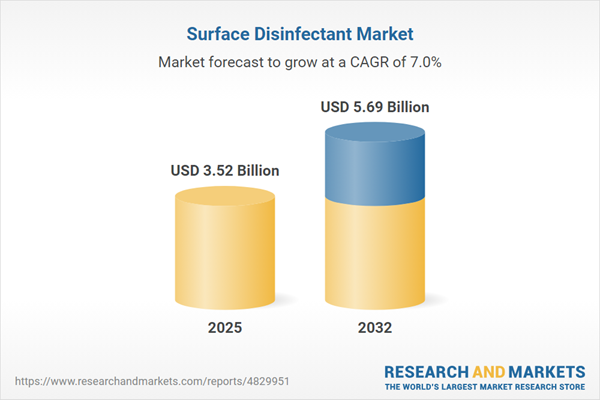Speak directly to the analyst to clarify any post sales queries you may have.
The surface disinfectant market is evolving rapidly, driven by escalating health and safety priorities across industries and regions. Senior leaders are seeking effective, sustainable, and regulatory-compliant disinfection solutions to meet expanding organizational and regulatory requirements.
Market Snapshot: Surface Disinfectant Market Size and Growth Overview
The Surface Disinfectant Market grew from USD 3.30 billion in 2024 to USD 3.52 billion in 2025. The market is projected to expand at a CAGR of 7.03%, reaching USD 5.69 billion by 2032.
The steady growth reflects intensifying demand for high-efficacy disinfection products as infection control expectations influence healthcare, commercial, and industrial sectors globally.Scope & Segmentation of the Surface Disinfectant Market
- Product Type: Bio-based disinfectants rooted in botanical or enzymatic ingredients; chemical-based solutions (alcohols, aldehydes, quaternary ammonium compounds, oxidizing agents, phenolics).
- Form: Liquids for scalable use; pre-moistened wipes and sprays for convenience; foams designed for extended surface contact.
- Application: Commercial spaces like institutional and retail environments; industrial facilities—including food processing and pharmaceuticals—emphasizing compliance; residential settings focusing on ease of use and safety.
- Distribution Channel: Offline through specialty retailers, supermarkets, and hypermarkets; online platforms catering to digital procurement trends.
- Regions Covered:
- Americas: United States, Canada, Mexico, Brazil, Argentina, Chile, Colombia, Peru
- Europe, Middle East & Africa: United Kingdom, Germany, France, Russia, Italy, Spain, Netherlands, Sweden, Poland, Switzerland, United Arab Emirates, Saudi Arabia, Qatar, Turkey, Israel, South Africa, Nigeria, Egypt, Kenya
- Asia-Pacific: China, India, Japan, Australia, South Korea, Indonesia, Thailand, Malaysia, Singapore, Taiwan
- Leading Companies Profiled: 3M Company, Acuro Organics Limited, Ark Chemicals, BASF SE, Becta Laboratories, Cantel Medical Corporation, CarrollCLEAN, Chemtex Speciality Ltd., Diversey Holdings, Ltd., Ecolab Inc., Evonik Industries AG, Gojo Industries, Inc., Medline Industries, Inc., Metrex Research, LLC, Navneet Chemical, Paul Hartmann AG, Procter & Gamble Company, Reckitt Benckiser Group plc, Sanosil Ltd., SC Johnson Professional USA, Inc., STERIS PLC, The Clorox Company, Unilab Chemicals & Pharmaceuticals Pvt. Ltd., Unilever Plc, Whiteley Corporation, Yogi Chem
Key Takeaways for Market Leaders
- The surface disinfectant market is shifting rapidly towards sustainable and eco-friendly solutions, with bio-based alternatives capturing the attention of environmentally conscious buyers.
- Digital technologies, including IoT-enabled dispensing and online training, are enhancing compliance tracking and standardizing application protocols within large organizations.
- Regional regulations and market readiness vary significantly, requiring organizations to tailor product portfolios and go-to-market plans by geography.
- Recent United States import tariffs have increased supply chain and manufacturing complexity, prompting manufacturers to prioritize domestic sourcing and supplier diversification.
- Strategic partnerships between material scientists, ingredient innovators, and end users are accelerating product development and market responsiveness.
Tariff Impact on Supply Chain Dynamics
The introduction of new US tariffs in 2025 has driven companies to reconfigure procurement and manufacturing strategies. Decision-makers are responding by boosting local production, re-negotiating with tariff-exempt suppliers, and refining inventory management to maintain reliability and financial efficiency. Data-driven analytics now guide decisions to optimize product portfolios and cost structures in an increasingly complex regulatory environment.
Methodology & Data Sources
This report uses mixed methods: structured interviews with senior industry stakeholders, qualitative insights from healthcare, commercial, and residential representatives, and extensive secondary data from journals, trade publications, and regulatory filings. Peer review and statistical validation techniques underpin analytical rigor.
Why This Report Matters
- Benchmark products, technology adoption, and sustainability initiatives against established leaders in the surface disinfectant market.
- Receive actionable intelligence on emerging segmentation, channel strategies, and regulatory challenges to inform investment, procurement, and innovation priorities.
- Anticipate supply chain risks and evolving regional compliance requirements to future-proof operational planning.
Conclusion
This report equips decision-makers with a clear landscape of the surface disinfectant sector, highlighting the intersections of innovation, global compliance, and supply chain adaptability. Senior leaders will find strategic guidance for sustainable growth and risk mitigation in evolving hygiene markets.
Additional Product Information:
- Purchase of this report includes 1 year online access with quarterly updates.
- This report can be updated on request. Please contact our Customer Experience team using the Ask a Question widget on our website.
Table of Contents
3. Executive Summary
4. Market Overview
7. Cumulative Impact of Artificial Intelligence 2025
Companies Mentioned
The companies profiled in this Surface Disinfectant market report include:- 3M Company
- Acuro Organics Limited
- Ark Chemicals
- BASF SE
- Becta Laboratories
- Cantel Medical Corporation
- CarrollCLEAN
- Chemtex Speciality Ltd.
- Diversey Holdings, Ltd.
- Ecolab Inc.
- Evonik Industries AG
- Gojo Industries, Inc.
- Medline Industries, Inc.
- Metrex Research, LLC
- Navneet Chemical
- Paul Hartmann AG
- Procter & Gamble Company
- Reckitt Benckiser Group plc
- Sanosil Ltd.
- SC Johnson Professional USA, Inc.
- STERIS PLC
- The Clorox Company
- Unilab Chemicals & Pharmaceuticals Pvt. Ltd.
- Unilever Plc
- Whiteley Corporation
- Yogi Chem
Table Information
| Report Attribute | Details |
|---|---|
| No. of Pages | 189 |
| Published | November 2025 |
| Forecast Period | 2025 - 2032 |
| Estimated Market Value ( USD | $ 3.52 Billion |
| Forecasted Market Value ( USD | $ 5.69 Billion |
| Compound Annual Growth Rate | 7.0% |
| Regions Covered | Global |
| No. of Companies Mentioned | 27 |









